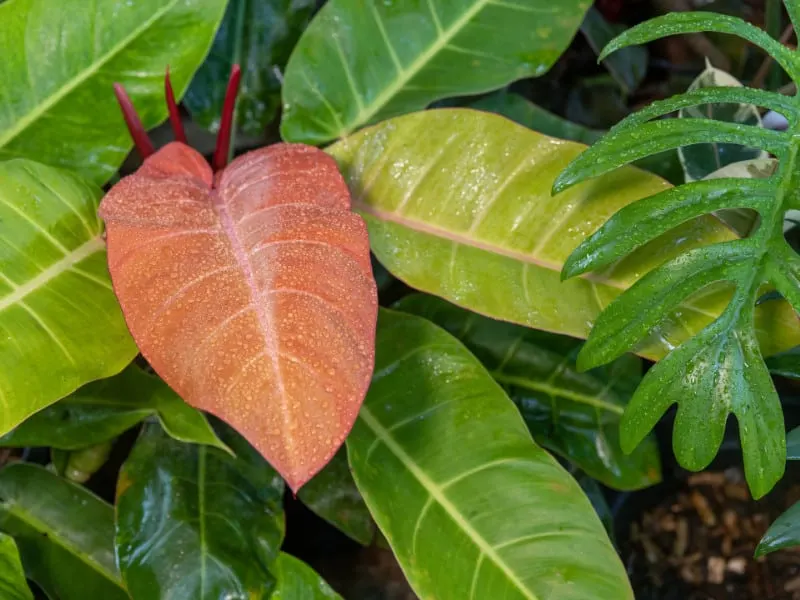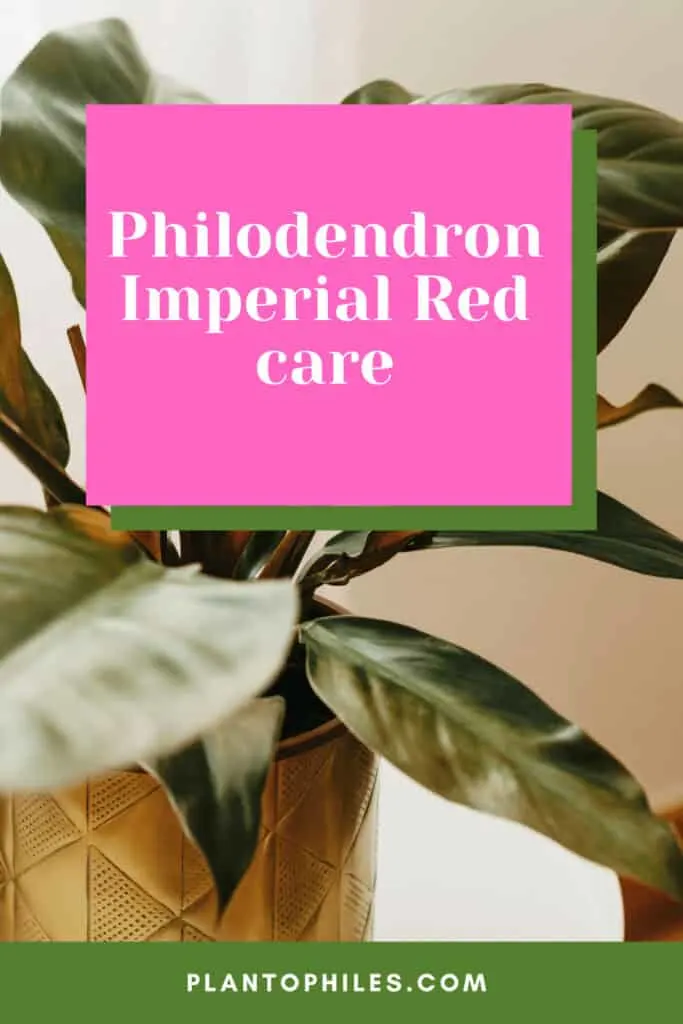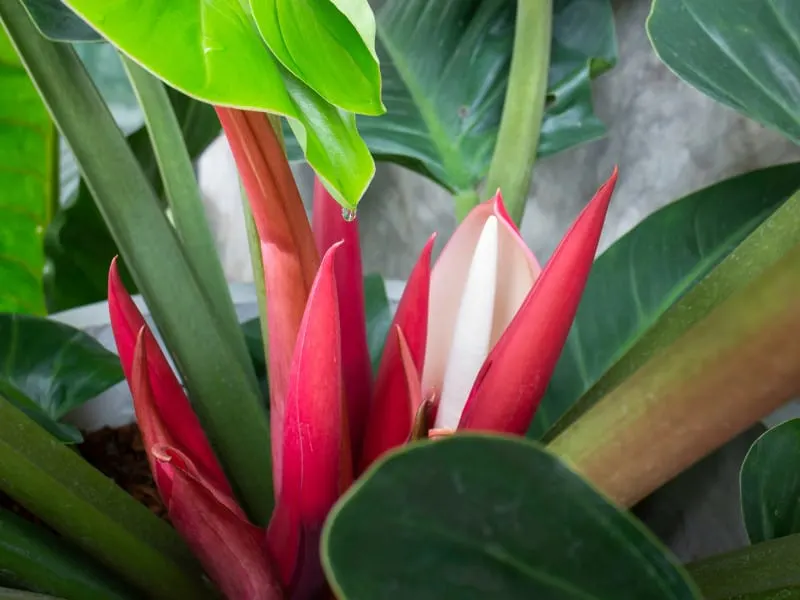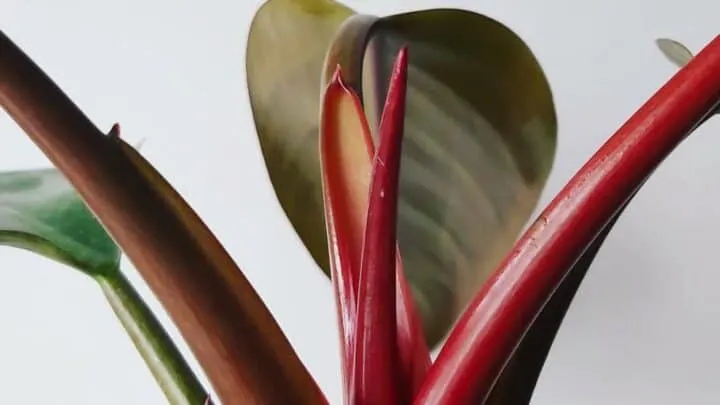You are reading this article because you are interested in Philodendron Imperial Red care and want to learn more about Philodendron erubescens ‘Imperial Red.’
The latest gardening trend, particularly among home growers, is compact tropical evergreens. Growing hybrid Philodendron cultivars is the new trend.
The Philodendron Imperial Red is easy to care for.

Philodendron erubescens ‘Imperial Red’ Takeaways
| Species | Philodendron erubescens 'Imperial Red' Takeaways |
| Synonyms | Philodendron Imperial Red |
| Family | Araceae |
| Genus | Philodendron |
| Growth | Self-heading |
| Height | 3 feet |
| Width | 4 feet |
| Soil | Well draining soil using peat, perlite, orchid bark, charcoal and some potting soil |
| Watering | Water every 7 to 10 days |
| Light | Bright indirect |
| Temperature | 65 to 80°F (18-27°C) |
| Humidity | 60-80% |
| Fertilizer | Fertilize every 2weeks |
| Propagation | Plantlets, seeds |
| Toxicity | Toxic to pets such as cats and dogs. Contains insoluble calcium oxalate crystals |
Table of Contents
Philodendron ‘Imperial Red’ Plant
Philodendron erubescens ‘Imperial Red’ belongs to the Araceae family. This plant family is also called Aroids.
Several nearly identical hybrids are doing the rounds in local nurseries and online stores. Let me help you identify this particular hybrid cultivar:
- The plant is a self-heading variety, with the leaves forming compact rosettes.
- The erubescens spreads laterally.
- The dark green leaves are ovate to elliptical, and the new leaves are tinged red.
- The foliage is glossy and somewhat wide.
- The midribs are almost the same color as the leaves.
- The petioles are a brownish green when mature. They are somewhat short compared to the leaf size giving the plant a compact, full, and bushy appearance.
Other popular Philodendron erubescens varieties are the Philodendron erubescens ‘Pink Princess, ‘ Philodendron erubescens ‘Painted Lady,’ and Philodendron erubescens common form.
Philodendron ‘Imperial Red’ Care
Philodendron “Imperial Red” is ideally suited for ambient room temperatures between 65 – 80°F (18 – 27°C). They can tolerate slight drought but prefer consistent moisture to look healthy. However, soggy soil is dangerous for the plant. Therefore, the potting mix needs to be very loose, porous, and well-draining. Bright shade, morning sunlight, and humidity above 50% are desired for good growth.

Philodendron Imperial Red Soil
You are meant to grow Philodendron “Imperial Red” indoors in a pot.
The potting soil you use must be very loose and porous so that it drains excellently and the plant roots get to breathe. Anything course and chunky works such as perlite, brick bits, coco chips, crushed bark, grainy river sand, etc.
Also advisable is to use plenty of organic matter in the mix for moisture retention and plant nutrition. After all, these are originally epiphytic, sustaining on organic debris collecting around the roots.
You can use peat moss, coco peat, leaf much, kitchen compost, dung manure, etc. to introduce organic content in the substrate. Just make sure that it’s well-decomposed and sterile. Otherwise the roots may be prone to infection.
The ratio of organic to inorganic should be about 50/50.
An easy Philodendron “Imperial Red” care hack is to mix in peat in a good quality cactus mix along with organic manure. It may be a little expensive but a great substrate to grow Philodendron “Imperial Red” in.
Philodendron Imperial Red Light
Philodendron “Imperial Red” care needs a decent amount of indirect sunlight for good growth. The wide and green leaves indicate that it adapted for bright shade. In fact, the red hue of leaves drains off in prolonged darkness.
You can grow Philodendron “Imperial Red” indoors by an east window or west window spot. In my own experience, receiving a bit of direct sun exposure in the mornings for about half an hour can do a whole lot of good. The trouble is that giving full direct sunlight all day will burn the foliage.
In the non-equatorial regions, you’ll have to grow Philodendron “Imperial Red” in fluorescent lights, particularly in the winters for 12 hours a day.
How to Water Philodendron “Imperial Red”
Water when the top two inches (5 cm) feel dry to the touch about every 7-10 days.
If you ask me, the only confusing part about Philodendron “Imperial Red” is watering. If it’s a drought-tolerant evergreen tropical, do you water it well? Or do you water it sparingly? Here’s what I’ve learned about watering these hybrid varieties.
Philodendron “Imperial Red” care involves a little more consistent moisture than the species you find in the wild, which are adapted to surviving periods of drought. But exactly what watering cycle would apply to really depends on a bunch of things.
The climatic zone you live in, season, the placement of the plant in your house, humidity, and most importantly, soil variety are factors you need to consider.
If the soil is perfectly well-draining, you can water regularly. In tropical weather conditions or what I call “land of always summer,” you’ll notice that the soil dries out pretty fast in the rainless months. You’ll need to water quite regularly there.
The top soil test is a good way to decide whether or not to water. If the top two inches feel dry, then water the plant. Under no circumstances should the soil be sticky and water-logged. That’s surely going to kill the plant.
Temperature
Philodendron “Imperial Red” loves warm air and grows best in tropical regions. That said, this cultivar is hybridized for indoor growing and takes will to the ambient temperatures of a heated room.
Room temperatures between 65 – 80°F (18 – 27°C) would work well for this plant. If the temperature gets warmer just place the plant in filtered light and hydrate sufficiently.
These plants have no frost tolerance. So temperatures below 55°F (13°C) are a strict no. Therefore in winters, you should keep the plant indoors always and out of the way of cold drafts.
Humidity
All tropical plants do well in a humid environment, and the Philodendron “Imperial Red” is no different. However, when kept indoors, this plant has to suffer the dryness caused by heaters and air conditioners.
I would recommend a humidity level anywhere above 50% for the best results in terms of growth and plant health. Try occasionally misting the plant with water, wiping the leaves with a wet sponge, and using humidifiers during the dry months.
You needn’t go crazy over ensuring humidity as long as the soil moisture is optimal. The plant can survive a bit of air dryness. That said, you’ll see a marked difference in plant health if you give the humidity it needs.
How should I Fertilize Philodendron Imperial Red?
Fertilize Philodendron Imperial Red every two weeks using an organic fertilizer.
I am not a fan of chemical fertilization for my Philodendron “Imperial Red”. My plants don’t seem to need a lot more than the organic soil amendments such as decomposed mulch, compost, organic manure, sterile animal dung, peat, moss etc. Organic matter mixed with rich soil acts as food for the plant.
I prefer organic manure over chemical fertilizers, particularly for tropical aroids like Philodendrons. ln their habitats they only get slow-release nutrient compounds in the form of leaf debris and rainwater.
That said, Philodendron “Imperial Red” care is better suited for home environments being a hybrid cultivar. So if you’ve been using chemicals in your plant care, you can extend that to this plant too.
Just some advice, use a good quality fertilizer. Cheap chemicals are harmful. I would recommend a liquid foliage boosting one. Liquids allow you to manage your concentration easily. You should thin down the chemical to one-third of the Rx dosage. If you over-fertilize, the plant can die.
Growth
Being a self-header means growing Philodendron “Imperial Red” in a pot almost forever. The leaf nodes of this plant are so closely packed together that the stem is invisible, and the plant looks like a bouquet of red tinted leaves. The plant naturally grows into a bushy voluminous shape with just a few leaves.
When you buy a young plant, you can grow Philodendron “Imperial Red” on a tabletop in a small-sized pot. The root systems are fairly compact, and the plant generates plenty of aerial roots that look quite trippy.
However, as it grows bigger, you will find that the plant gets top heavy. Philodendron “Imperial Red” care doesn’t call for regular pruning. You must cut away discolored leaves, stems, and dead aerial roots to maintain a clean look.
It is advisable to prune the head of a Philodendron “Imperial Red” only if they are very mature plants that have sprung multiple heads at the base.
Philodendron Imperial Red Blooming
The Philodendron Imperial Red produces an inflorescence called a spathe and a spadix. This is typical for Aroids. The spathe is a modified leaf and red on this plant. The spadix is white to creamy white.
The erubescence flower goes through a female and male stage. In the female stage it is receptive and in the male stage it produces pollen.
I have yet to successfully pollinate my plant as you need one or several plants in both stages. I have also frozen some pollen that I can use later.

Potting
You can easily grow Philodendron “Imperial Red” in a relatively small pot for a length of time until stability becomes an issue. I stake my plant sometimes if required. But it isn’t always necessary.
They are very happy being root-bound. The roots of this plant develop well and tend to grow tightly around any chunks in soil like brick bits or bark. It also develops aerial roots that add to the aesthetics of the plant.
I will recommend repotting only when they get top-heavy, and the roots pour out of the existing pot. I advise you to remove the plant and the root ball and move it to a larger pot. Repotting may be required only once in 2-3 years. Repotting must be done in the spring and summer months.
Propagating Philodendron “Imperial Red” – Step-by-Step Instructions
Professional botanists propagate Philodendrons “Imperial Red” using techniques that aren’t feasible for home gardeners, such as from seeds or through tissue culture.
The Philodendron “Imperial Red” cultivar was created to be a manageable houseplants that don’t climb aggressively. Unlike climbing Philodendrons, Imperial Red doesn’t have nodes and internodes to get cuttings from.
For self-headers such as Philodendron “Imperial Red”, the methods are more complex and usually not feasible for home gardeners.
However, there are workarounds to this if you’re patient enough. Under optimal growth conditions, Philodendron “Imperial Red” will produce plantlets at the base that can be potted separately once they have a few leaves and a little stem.
I am going to share methods that have worked for me. The thumb rule of Philodendron “Imperial Red” propagation is to carry it out ONLY in warm weather in moderate to high humidity conditions. Spring is the ideal time. This greatly impacts the chances of success.
Propagate Philodendron “Imperial Red” from plantlets
In this method, you have to wait until nature is ready to propagate. The plant decides the right time for you. It may take until the Philodendron “Imperial Red” plant is mature.
- You can look for little plantlets at the base of the plant where the stem is visible after the old leaves fall off.
- Wait for the plantlet to grow big until its stem is visible.
- Placing the plant in a brightly lit spot helps the plantlets emerge sooner
- Look for a plantlet that has aerial roots.
- Air-layer the stem (detailed below) to helps the roots grow bigger. Air layering should take about 2 to 3 weeks
- When ready, cut the plantlet off the mother and pot it separately in soil.
- Continue with Philodendron “Imperial Red” care as usual.
How to air-layer your Philodendron “Imperial Red”
Keep a 6” transparent plastic bag, sphagnum moss, and twisty ties ready.
- Punch a few small holes at the bottom of your plastic bag and put a fistful of wet sphagnum moss at the bottom.
- Fashion the plastic bag like a wrap that can go around a stem.
Now let’s get to the plant.
- Look for small aerial root projections at the base of the plantlet.
- With a blade, make a tiny slit under the node where you want your plantlet to root. About 2mm deep should be good.
- Hold the moss and plastic bag against the cut on the stem with one palm.
- Fold the plastic flaps around the stem with the other hand. Secure this bag of moss using twisty ties, so it doesn’t slip off. The roots will grow into the moss cocoon.
- Keep the arrangement moistened with water through the holes in the bag.
- After a couple of weeks, the roots have grown into moss.
- Remove the plastic and the moss carefully without breaking your new roots.
- Now cut the plantlet below the new roots with sterile sheers.
- Pot the cutting and grow it in the shade until the new plant is well established.
Common Problems with Philodendron “Imperial Red”
Irregular brown patches along the leaf edge
This is one of the most common issues growing Philodendron “Imperial Red.” It is caused due to a bacterial infection called Erwinia blight. This is mainly caused due to overhead watering, according to PennState University.
They recommend removing the damaged leaves and watering to keep the leaves and petiole dry at all times. Make sure you discard the leaves far away from all the plants.
Translucent leaf spots
Do the spots have yellow margins and a disagreeable smell to the fluid inside? Then this must be another infection caused by Xanthomonas. You have to make sure the plant is free of it when you bring it home from the nursery. The rest of the cure and care is as above, i.e., avoid overhead watering and keep the plant leaves dry as far as possible.
Dark patches on the leaf
This happens due to cold drafts, even for a few hours. Remove the damaged leaves and immediately shift your plant to a location away from open windows and doors.
Leaves yellowing
Yellow leaves are typically an indication that you’ve been overwatering. You need to take immediate steps to improve your pot’s drainage by adding soil amendments. You also have to elongate the watering cycle generally.
Brown crispy edges
You could be underwatering your plant. Gradually improve the watering. Once the plant is well adjusted, you can water deeply and wait until the soil dries out partially.
Pale leaf color
If the characteristic red-tinted color of the leaves starts fading out or turning more green, Philodendron “Imperial Red” needs to be moved to a brighter spot. Low light drains the leaf color.
Common pests
When you grow Philodendron “Imperial Red,” severe pest problems and insects are not commonly experienced. You may see an occasional attack of aphids, fungus gnats, or mealybugs.
The ideal preventive measure is the application of insecticidal soap mixed with neem oil administered once a month or as prescribed on the package.
My Philodendron “Imperial Red” care routine includes washing the leaves with a water jet once a week when I water the plant and wiping the leaves dry.
Severe infestations require chemical treatment, but you shouldn’t let it get to that stage.
Tips to keep Philodendron “Imperial Red” problem-free
- Keep room temperature in the 65 – 80°F (18 – 27°C) range throughout the year
- The plant has zero frost tolerance, so keep it away from cold drafts indoors
- Bright lighting is the best way to grow Philodendron “Imperial Red”
- Philodendron “Imperial Red” does best with organic feed supplemented with well-balanced dilute chemical fertilizer
- Maintain even moisture during growing months
- Wet wipe the leaves regularly to prevent pests and dust accumulation
- Dry out the leaves after wiping in order to avoid bacterial infections
- Grow Philodendron “Imperial Red” in a compact ceramic planter heavy enough to prevent toppling
- Repot in spring just in time for the growing season
Frequently asked questions about Philodendron “Imperial Red”
Is Philodendron “Imperial Red” toxic to pets?
If this plant is chewed, it can be toxic to dogs and cats due to calcium oxalate crystals. The plant causes mouth and stomach irritation.
Why does Philodendron “Imperial Red” turn red?
This plant can exhibit red pigmentation when the growing conditions fluctuate too much. Fluctuations in watering, temperature, and light are common reasons.
How do I make Philodendron “Imperial Red” look fuller?
If your plant isn’t growing new leaves for months together, it may lose its compact look. To get back that look, fertilize with gentle low-dosage feed every two weeks and improve lighting. If that doesn’t help, then perhaps the roots are overgrown. In that case, it’s time to repot with rich soil.
Should you mist Philodendron “Imperial Red”?
Periodically showering the plant with water and applying insecticidal soap will help keep pests at bay. Besides, philodendrons are tropical plants, so higher humidity will promote lush growth and shiny foliage.
Just watch out for bacterial infections which spread due to moisture.
Read about Philodendron serpens care next.
Conclusion
Due to a pandemic-induced spike in work-from-home setups, many people want to add a splash of green to their living spaces. That is perhaps the reason behind the resurgence in Philodendrons, Monsteras, Anthuriums, and other aroid varieties.
Self-heading philodendron varieties have been hybridized to suit home-growing environments. However, there are other species of aroids suitable for indoor growing which you could consider too.
I encourage you to explore Monstera Adansonii and Anthurium pallidiflorum, great exotic plants for an indoor tropical corner.
Happy growing! I hope Philodendron Imperial Red care is now a bit clearer.

Daniel has been a plant enthusiast for over 20 years. He owns hundreds of houseplants and prepares for the chili growing seasons yearly with great anticipation. His favorite plants are plant species in the Araceae family, such as Monstera, Philodendron, and Anthurium. He also loves gardening and is growing hot peppers, tomatoes, and many more vegetables.


